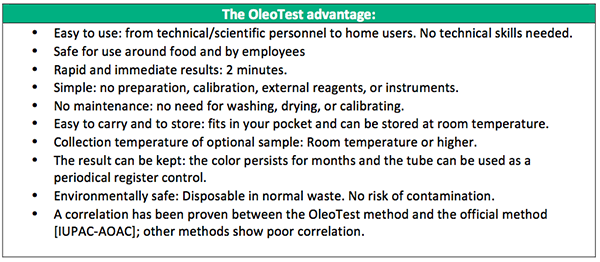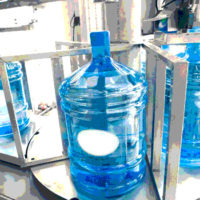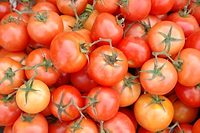Nowadays, deep frying foods is one of the most widespread culinary and industrial cooking techniques in the world. But with an emphasis on healthy eating on the rise, information about food sources has become more important to consumers. So, even though the appeal of fried foods remains strong, it is prudent to offer the consumer some assurance of care and attention to detail regarding the health and quality of your menu items and fried products. Monitoring the composition of fryer oil for its polar content is a key step in producing a desirable, quality fried product. In this paper, we will explain how polar compounds are created and then how they can be easily monitored.
How are polar compounds created?
Oil Alteration
The technique of deep frying involves a series of complex processes that affect the composition of both the oil and the product being fried. Each type of product has several variables that affect the optimum deep frying conditions:
- Temperature of the oil
- Frying time
- Continuous or discontinuous deep frying
- Composition of the oil
- Food moisture
- Food coating
- Food volume/surface
The moisture contained in foods, atmospheric oxygen, and high temperatures (320° – 400° F) produce reactions such as hydrolysis, oxidation and polymerization. These reactions change and modify the chemical composition of the used frying oils, releasing free fatty acids and free radicals that in turn combine to make monoglycerides, diglycerides and polymeric trigylicerides. All of these products of alteration are considered polar compounds and grouped under the term Total Polar Compounds, which is a reliable benchmark for measuring the degradation of the oil.
Since these polar compounds are not digestible, consumption can impact consumer health, posing a greater risk of heart disease in the long term and gastrointestinal disorders in the short term. Expired oil renders the fried foods greasier and negatively impacts flavor and color, detracting from the appeal of the product.
Monitoring fryer oil for polar content will ensure that the product is of consistent quality, and won’t have a negative impact on consumer health.
Hydrolysis and the Release of Free Fatty Acids
The water content of food is necessary in the deep frying process, creating a protective layer that simultaneously prevents oil from penetrating the product and allows the product to cook thoroughly. As the water evaporates, fatty acids, monoglycerides, and diglycerides are released. During hydrolysis, water alters the bond between glycerol and fatty acid, and is then itself split into two parts. One part attaches itself to the free radicals, while the other remains attached to the fatty acid radical. The hydrolysis derivatives increase the oxidation and reactivity higher than the original triacylglycerides, which in turn accelerate degradation. The intensity of this process depends on different factors:
- The quantity of water from frozen foods or foods rich in water interacting with the frying oil or fat.
- The surface/volume ratio of the food being fried (the greater the value of this proportion the greater the
- contact between the oil and the water from the product).
- The excessive presence of residual solid particles in frying oils accelerates the formation of free fatty acids.
- At temperatures of 360°-400° F, the hydrolysis process is insignificant, since moisture is eliminated in the form of steam. The greatest modifications are produced if there is moisture at the moment of heating or cooling the oil (<200° F), and during its storage.
The development of free fatty acids in oil occurs at the same time as the other alterations that take place during the frying process. In addition, the free fatty acids are a negative factor, since they alter the smoke point of the heated oil, and contribute to undesirable smells and flavors.
Oxidation and the Formation of Free Radicals
Oxidation is the most frequent modification to oil during the deep frying process. The process occurs when fatty acids and other unsaturated molecules are exposed to atmospheric oxygen, generating intermediate unstable compounds called hydroperoxides or peroxides. These compounds result in the formation of free radicals.
.png) During the process of oxidation, new changes appear, such as flavor alteration, decreased palatability, and darkening of the oil. The process of oxidation is further accelerated by light. Ultraviolet rays in particular trigger conditions for oxidation. Physical changes in the oil, like an increase in viscosity and formation of scum can be seen but chemical changes, like the formation of polymers and volatile compounds, are invisible. Nonvolatile compounds are retained in the oil and absorbed by the product, ultimately reaching the consumer. This is the reason why the levels of these derivatives in frying fats and in a fried product should be known. Many countries have already enacted legislation to monitor frying oils.
During the process of oxidation, new changes appear, such as flavor alteration, decreased palatability, and darkening of the oil. The process of oxidation is further accelerated by light. Ultraviolet rays in particular trigger conditions for oxidation. Physical changes in the oil, like an increase in viscosity and formation of scum can be seen but chemical changes, like the formation of polymers and volatile compounds, are invisible. Nonvolatile compounds are retained in the oil and absorbed by the product, ultimately reaching the consumer. This is the reason why the levels of these derivatives in frying fats and in a fried product should be known. Many countries have already enacted legislation to monitor frying oils.
Excessive consumption of toxic substances originating from oxidized oils may cause, among other conditions, different types of gastrointestinal disorders.
Polymerization: The Combination of Free Fatty Acids and Free Radicals
Free radicals tend to combine with each other or with other fatty acids, and tend to form long and ramified lineal compounds, or cyclic compounds. The cyclization of fatty acid molecules is one of the main reactions produced due to the intense heat in the deep frying process.
The most important group of alteration compounds are the dimers, trimers and polymers of the triacylglycerides. Their formation is also catalyzed by the high temperatures reached during the process of deep frying. Dimers, trimers and polymers can be of two types, depending on whether they are combined with oxidized radicals or with nonoxidized radicals:
- Nonpolar dimers and polymers (nonoxidized)
- Polar dimers and polymers (oxidized)
These polymers tend to increase the viscosity of the oil. This contributes to the formation of foam, which eases the oxidation, but leaves the product soaking in a greater quantity of oil. Another important side effect of the formation of polymers is that the polymers form a layer of plastic consistency that is very adhesive and difficult to remove from the fryer surface.
.png) Not only are these polymers difficult to clean, they appear to be indigestible. The shortest compounds, monomers, and dimers, are absorbed by the intestinal walls, with a detrimental effect on the consumer’s health. Many of these substances are recognized as toxic or potentially carcinogenic.
Not only are these polymers difficult to clean, they appear to be indigestible. The shortest compounds, monomers, and dimers, are absorbed by the intestinal walls, with a detrimental effect on the consumer’s health. Many of these substances are recognized as toxic or potentially carcinogenic.
Monitoring Heated Oils and Fats
There are many criteria and different analytical techniques available for assessing the state of frying oils and establishing when they should be discarded, for example refraction value, grade of acidity, peroxide value, iodine value, polar compounds, or dialectic content. However, testing for Total Polar Content can account for the all of the degradation products produced during the deep frying process.
Total Polar Compounds affect the consistency of deep frying by increasing the release of water and the absorption of fats into the product. French fries, for instance, will brown but will be hollow because the moisture has been released too quickly.
Hazard Analysis and Critical Control Points (HACCP) and ISO 9000
HACCP and ISO 9000 are guidelines for accountability in food safety from raw to finished product. Manufacturers who implement these guidelines optimize their processes through monitoring, documentation, and action.
Of the many components in a plan for quality control, frying oil quality is a key step. Identifying critical control points in the frying process dictates how and when monitoring takes place. Documentation of the forms of monitoring leads to a better understanding of the issues that contribute to the degradation of frying oil. Most crucial is developing a protocol on when and what action takes place to conform to the quality control plan.
Rapid Method for the Determination of Polar Compounds: OleoTest
There is a need to monitor the quality of frying oils in a reliable and rapid manner, because even when no signs of oil degradation are visible the oil could still have been used in a poorly calibrated deep fryer, making the percentage of polar compounds exceed a healthy limit.
 To fulfill this need, OleoTest has been created: a reliable, rapid, and economical method to assess the degree of oil alteration through the measurement of polar compounds.
To fulfill this need, OleoTest has been created: a reliable, rapid, and economical method to assess the degree of oil alteration through the measurement of polar compounds.

Emport LLC specializes in food testing kits that combine user-friendly design with scientist-friendly standards. Visit Emport LLC online for more information.



